NZFMM
Main menu:
- Home Page
- About NZFMM
- NZ Meccano Clubs
- NZFMM Magazine information
- Interactive Models
- April Antics 2010
- Te Papa Meccano Display 2010
- Te Papa Meccano Display 2012
- Historical NZFMM conventions
- 1993 Auckland Convention
- 1995 Christchurch Convention
- 1997 Feilding Convention
- 1999 Auckland Convention
- 2001 Wellington Convention
- 2003 Hawera Convention
- 2007 Wellington Convention
- 2009 Christchurch Convention
- 2011 MWT Palmerston North Convention
- 2013 Auckland Convention
- 2019 MWT Inglewood Convention
- 2021 Wellington Waikanae Convention
- 2023 Christchurch Tinwald Convention
- 2025 Whanganui Convention
- Articles
- Literature indexes
- Where to buy Meccano
- Links
1997 Feilding Convention
NZFMM 1997 Feilding Convention Introduction
The 1997 Bi-annual meeting of the New Zealand Federation of Meccano Modellers was held at the Feilding Civic Centre.
Daryl Anderson's Fairground
All three of these models below were built by Daryl Anderson. They made up a side show collection, including Dodgem Cars, Merry-go-round and Octopus, all of which are are shown here. There were also Balls in Clowns' Mouths, Throw A Dart, Shooting Gallery, entrance and fences. Daryl won the Bruce Baxter Memorial Trophy, the Public Choice Trophy and the F.W. Cave Ltd - Master Modeller Prize for this combination model.
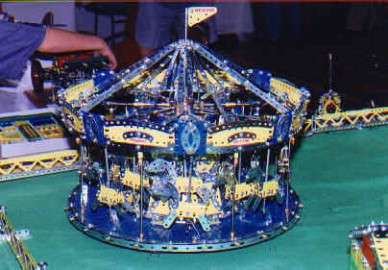
This colourful model was adapted from a model of Keith Cameron's published in the MMGG 13, September 1988.
There are sixteen horses arranged two abreast in eight rows. Daryl used a video recorder motor to power it.
This Octopus Ride is Daryl's own design. It is powered by a windscreen wiper motor. As in the real ride, the arms rotate one way and the offset pivot the other, creating a wave effect. The lights on the arms are switched on and off by a half ring which makes the red then green bulbs turn on and off. The arms are 12.5" long and pivot off a strong central tower and bearing.

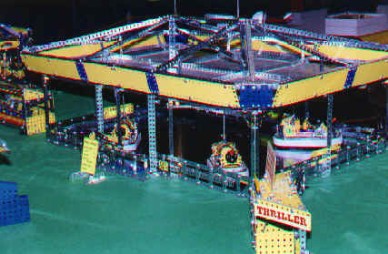
Dodgem Ride. A 6 speed powerdrive motor is used in each car. Daryl found that 9 volts was about right on the motors for good performance and quietness. The only problem was that 9 volts was not enough for reliable electrical pickup, so he increased the voltage to 20 and put a three terminal voltage regulator in each car to reduce it back to 9.
Daryl had the same fairground organ music playing through speakers in two of the models. Two little five inch speakers managed to fill the whole hall with music. The throw a dart and shooting gallery were conceived mainly to hide these speakers in.
Don Wilson's Submarine
Don Wilson of Wanganui is New Zealand's premier master builder of large exhibition models. He has regularly produced outstanding models for the biannual NZFMM Easter Exhibitions. The model below, exhibited at the 1997 Feilding Exhibition, is his latest masterpiece.
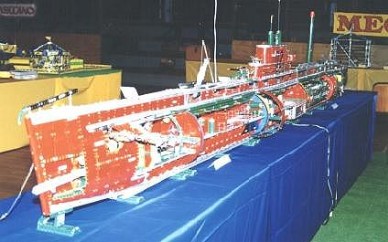
This immaculately detailed submarine is 18 feet long! The Webmaster sincerely regrets that Don did not use yellow Meccano or that the Beatles can't rewrite their song! Don's submarine was not modelled on any particular class. It has two snorkel tubes, 2 inch in the stern and 6 inch in the bow.
John Ince's H.M.S. Endeavour
H.M.S. Endeavour was the ship used by Captain Cook who sailed from England in the 18th century on a voyage of discovery especially in the Pacific Ocean. The ship was tiny by today's standards with an overall length of 106 feet. The Meccano model, built by John Ince, is to a scale of 1:65 this being determined by the 5½" x 2½" flexible plates used for the sails. They are yellow of Binns Road vintage. Most of the rest of the model is constructed from strips in a shiny nickel finish.
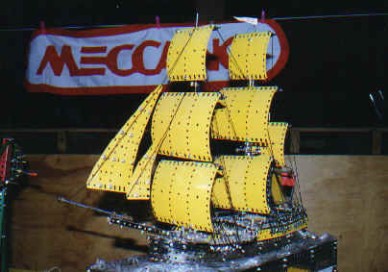
H.M.S. Endeavour. The model rests on a sea of clear plastic film, crinkled to represent the water. Underneath is a mechanism which imparts both pitch and roll to the ship. These two motions are out of phase so that the viewer may experience a degree of discomfort - sea sickness? - if the motion is watched for too long.
The model enjoyed a brief period of glory when positioned beside the gangway onto the full size replica which visited Lyttelton, the port for Christchurch. John built the model in time for the 1995 Christchurch Convention. It is likely to reappear at the 1999 Auckland Convention if it remains seaworthy!
An article on this model was also published in the May 1997 Journal of the International Society of Meccanomen.
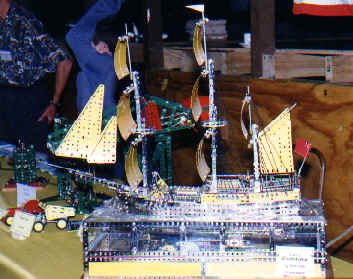
Giant Walking dragline by Don Blakeborough
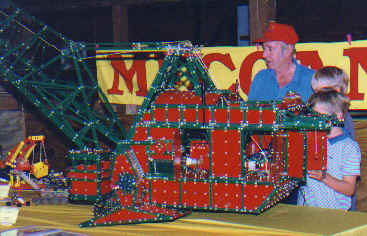
Don Blakeborough and his magnificent Giant Walking Dragline! The detailing of the model also includes the gantry mechanism at the rear of the crane for lifting machinery in and out of the crane.
Don used converted Black & Decker power Screwdrivers for the five main motors: slewing, walking, boom height, dragging & hoist. Diesel motors were run by Saturne Reducteur motors. Fans to cool the motors were both Crane motors. The warning device when slewing was operated by a 6 speed motor.
The machine was operated by umbical cord from a small control panel.
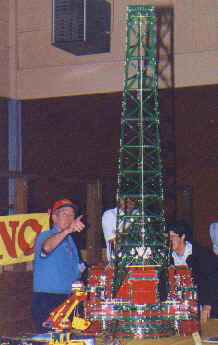
Bulldozer, Tractor and Trucks.

Caterpillar D5H Bulldozer by Bruce Geange
This model uses the plastic flexible track that was manufactured by the Binns Road Liverpool factory. Apart from that, the model is constructed in current parts and colours.
Ferguson 35 Tractor by Barry Babbage. It has a functional clutch, gearbox, differential and steering. The only non-Meccano part is the electric motor (German brand). Barry set himself the goal of only utilizing standard Meccano parts but not restricting to any era or vintage. The throttle lever for example consists of a plastic part from a modern truck set, while the generator is part No 163, but the older shorter version sleeve piece.
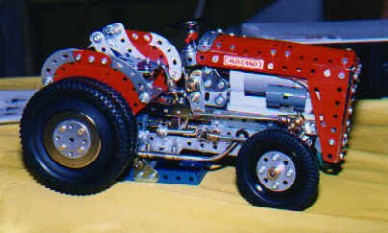
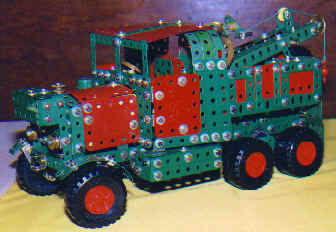
6X4 Scammel Wrecker by Bruce Geange.
1920 Tip Truck by Bruce Geange. Again Bruce has shown his outstanding attenion to finish in this period model.
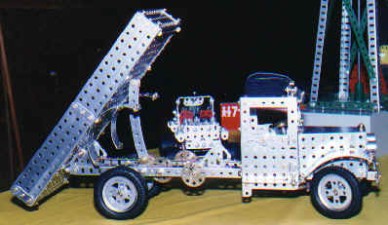
Cranes and Bridges
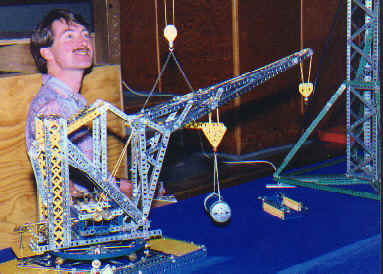
Brian Jones, Wellington with his Pontoon Crane. This is a variation of Super Model Leaflet Number 28. These cranes floated on "pontoons" and were moved around a harbour or dock to where they were needed.
Another Super Model Leaflet Model: Stiff Leg Derrik, Number 6 by Bruce Geange. The original model used an electric motor, but here Bruce has used his replica Meccano vertical steam engine.
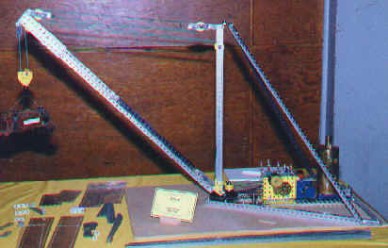
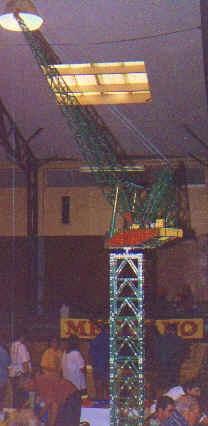
Construction Crane, by Simon Moody, Wellington. The tower was 7 feet tall with a 7 feet long jib. Level luffing was accomplished using the Topliss System. The jib was raised and lowered by imitation hydraulic rams, cylinders of which were made from part 216 cylinders joined by bolts and couplings on the inside acting as captive nuts. 6mm screwed rod pushed out 3/8" brass rod so that the threaded section could not be seen.
On this type of crane a wire rope comes off the jib a short way up and this pulls a tail weight out under the crane as the jib is lowered to a greater radius. In Simon's model this was reproduced but it also stretched 5 large springs concealed in the body of the crane to counteract the load of the jib on the rams. The tail weight was a large mass of lead that balanced the jib.
An original Binns Road display model: London Tower Bridge. It was originally owned by Collinson & Cunningham in Palmerston North. This firm was bought out by Farmers Trading Company.
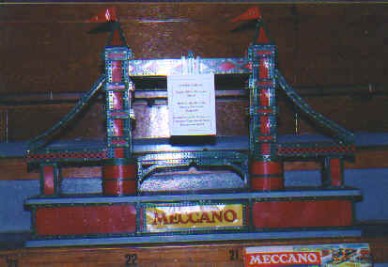
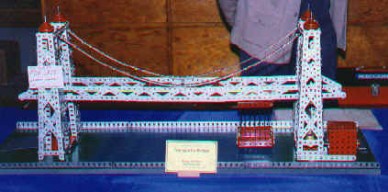
Transporter Bridge by George Ovenden of Auckland.